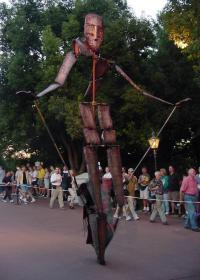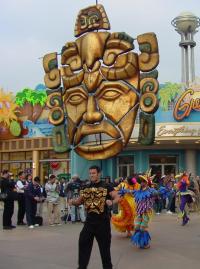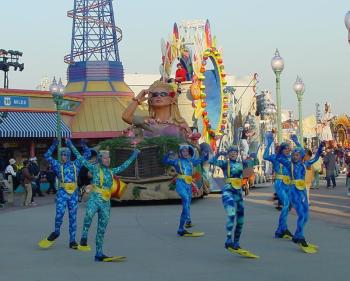An Interview With Steven Davison - Part 1
Page 3 of 4
 |
 |
| Tapestry of
Nations Click here for a much larger version of this picture (522 X 730, 72,822 bytes) |
Eureka! Click here for a much larger version of this picture (539 X 725, 72,622 bytes) |
I really started to play off what Michael started with Tapestry and then really kind of bent it a little more as we played in Oregon because Michael’s shop is up in Oregon. And it’s just fun because you’re sitting around and you create. You basically just say what ifs, what if we do this, can you get the Golden Gate Bridge to walk down the street. Can we get these giant sun fans with faces and just have them be a piece. The jumping stills are the same thing. They were kind of brought to us and I was fascinated by them and I threw them at the choreographers and it was a challenge.
Even the lighting and even the sound for this is really sophisticated and there were big challenges to overcome and the hardest part is it’s a brand new park. So you don’t have a sound system that’s been working for 20 years - it’s all new and the lighting is all new. So you go through those growing pains. You kind of had to take big breaths and you sit there and it took a lot of time to get everything up and working. It’s always nice to have this month of previews just to change and say, "what if we did do this, what if we played with this number." We moved dancers around. We moved costumes around. We got rid of all the spandex in the parade. Edwin Pinski out of Las Vegas did the costumes and I loved the original sketch but as we got into it, it actually never kind of fulfilled what I wanted it to. People spent more time looking at the spandex in yellow than they did watching the opening dancers. Then the opening dancers got self conscious and we said, "you know, let’s change it. Let’s just change the look. Let’s change the idea."

Fun in the Sun
Click here for a much larger version of this picture
(950 X 763, 115,230 bytes)
And so we just started to play with that and implement that. So as we go through the parade we’re actually re-developing some stuff and making it fit better, making it work. Because I think that’s the big deal. If you watch something and something distracts you - a great example is the spandex. Here’s spandex 101: If you look at the fish type dancers, the spandex doesn’t bother them. Nobody ever mentions it because they have a puppet device and b) the fabric is so varied in style and texture that you don’t react to it the same way as a giant yellow shape coming at you. So we started to play with that and slowly change out. We still have another week to do change outs and stuff. But we didn’t give up color - that’s the big deal. The opening is still bright yellow and bright red and very eye popping colors like this.
Colors are a big, big, factor in that parade. I think that we tried to get very specific as we hit different units. Even like the lighting design. If you watch the parade at night the lighting travels through the parade. It’s very sophisticated. Like when Pacifica comes out, it’s a very different pallet than when Folklorico comes out. They balance between warm and cool colors. Then when we hit the stop moment it all unites itself and becomes one piece. But we do it so hopefully you’re not watching the lights all the time or looking at this or even how sounds transition in the parade.
LP: With this being a new park, were you able to do some things that you couldn’t do at Disneyland?
SD: We got to be contemporary. We got to be very theatrical. A lot of people questioned, initially, if this was a character parade and I said you know, it’s not. And the biggest thing that I love so far is no one has asked. People watch the parade and no one leaves it going "I didn’t see Mickey or I didn’t see Minnie" and what I tried to teach the people is that the minute you influence a parade with a character overlay you have to change the whole piece. If Mickey and Minnie were in the parade as it is today, they would feel very disjointed because it’s not toonish, in a sense. They don’t have a reason for being there and we really wanted to stay pure to those communities. That when you see it, it really feels like a community. It kind of speaks to that. Minnie in a Folklorico outfit wouldn’t do that because you’d spend more time sitting there going "oh, that’s cute" and we’d have to have her talk. It’s distracting to me. So I was very gratified that they let us go that route. They had faith in us to do it.
LP: What about technically? Were there things you couldn't otherwise do or special challenges?
SD: Huge challenges to the point of - I remember our first technical meeting on lighting and sound and I took the technical designers through it and they just looked at me in horror. And after we heard the music the first time they said "we were terrified that you were going to ask to do what you just asked us to do" which is travel lights down the route, make lights interact with music and honestly, we don’t do that at Disneyland. They did do it during Light Magic but they Souped-up the entire system to handle it in two show stops. Here we are asking all 33 zones in the park to manage itself. Then when we got to the part about when we do the stop, I wanted the whole route to change into one color. They were like "oh my gosh." They had to completely re-write the programs on how we do it. Jim Holliman literally recreated how we think about this. They tested it at Disneyland one night and had some great reactions and then it was laborious. It’s literally laborious to get the computers to sync up because if you imagine we have six units and every unit has a different sound track so every sound track has to link within itself. All the songs work together on a continuous loop beginning to end. As they travel from zone to zone they all have to switch in the computer, plus all the lighting has to switch in the computer, plus all the animation is controlled by the computer, plus all the floats are RF so that’s another challenge. And then when we get to a show stop, everything has to stop take another cue and switch. That’s a monstrous task, and for me it’s like "can we do this, can we do that?" Because I think that way. I think about "oh this would be cool if we can do it" and I really push our people to go for it. I said, I’d rather go for it and cut it than not try it. I said, it’s not going to hurt us, we've got some time, let’s try it and they really worked like dogs to make that happen.
